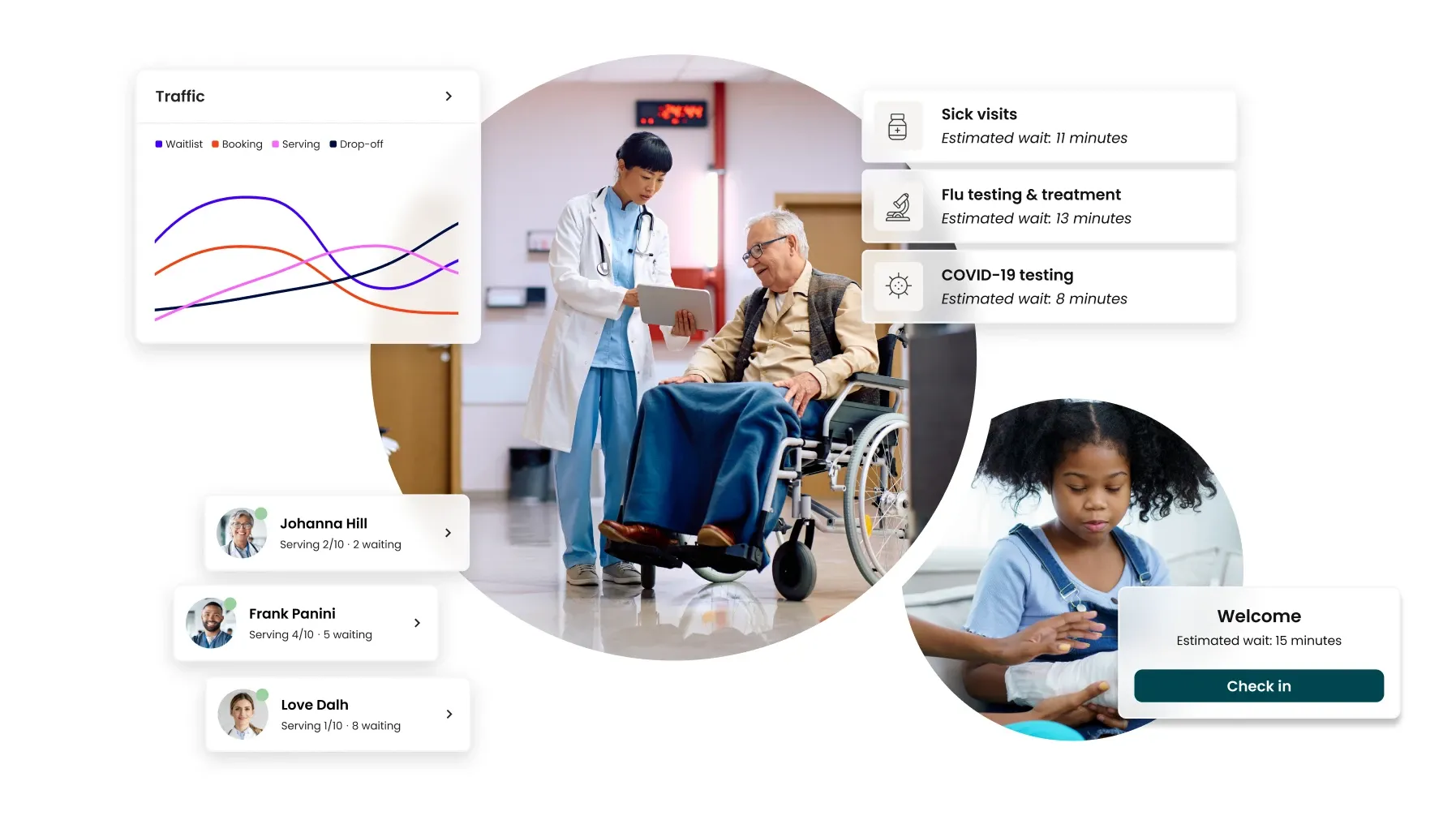Patient flow management is a critical issue for urgent care clinics. Poorly managed patient flow can lead to long wait times, overcrowding, and frustrated staff and patients. To provide quality care and increase patient satisfaction scores, it’s essential for urgent care clinics to have a sound system for managing patient flow.
Many urgent care clinics rely on manual forms of queue management, like using pen and paper to keep track of a printed waitlist. Not only is this process tedious for staff to manage, but it’s also inefficient. You’re not able to give patients accurate wait times, which can lead to a frustrating waiting experience during a time that is already stressful for patients.
With a virtual queue management system, you can unlock key efficiencies for your urgent care practice and automate patient flow. A system like Waitwhile allows you to operate virtual waitlists, appointment scheduling, and messaging with ease. Plus, it’ll deliver accurate AI-powered wait times so patients know what to expect.
Keep reading to learn more about how to effectively manage patient flow with a queue management system to increase the efficiency of your urgent care operations while making staff and patients happier.
We’ll cover:
- What is patient flow?
- Benefits of optimized patient flow
- Patient flow management challenges
- Solving patient flow issues with a queue management system
What is patient flow?
Put simply, patient flow is the movement of patients through a healthcare facility. It involves every step of the service process from making an appointment (or walking in for care) to being discharged from the facility and following up to check up on progress.
The goal of patient flow management is to ensure that patients move through your clinic in a timely and efficient manner, without compromising care.
Managing the flow of patients in a healthcare facility comes with a unique set of complications. Oftentimes, a visit to an urgent care clinic is not as cut and dry as, say, a visit to a store to return an item. There are a lot of unpredictable variables that come into play with every patient based on the severity of their case – and they have impacts on your patient flow.
A number of factors can impact the flow of patients at a healthcare facility. These include:
- Unpredictable patient volume: Many urgent care centers operate with a walk-in model, so it’s often difficult to predict when it’ll be busy.
- Appointment scheduling: Some practices also allow patients to schedule appointments in advance. Managing both appointments and walk-ins together can get tricky, especially if you’re trying to do it manually.
- Cancellations and no-shows: Canceled appointments or patients who do not show up can disrupt the overall flow.
- Patient acuity: The severity of a patient's condition can determine how quickly they need to be seen.
- Staff availability: The number of staff available to see patients can impact wait times and patient flow.
Without a clear cut way to effectively manage all of these moving parts, your practice can run the risk of a non-optimal patient flow. Hiccups in your patient flow management can have negative cascading effects with long wait times leading to frustrated patients who then make the work environment more challenging for your staff.
Benefits of optimized patient flow
That’s why paying particular attention to how you can optimize your patient flow is essential.
Here are just some of the benefits you’ll see:
- Reduced wait times: Wait times can be reduced by minimizing disruptions and ensuring patients are seen promptly.
- Increased efficiency: You’ll be able to serve patients faster, and eliminate time wasted on non-essential tasks like queue management.
- Improved patient satisfaction: When patients don’t have to wait long to be seen, they’re more likely to be satisfied by their overall experience.
- Reduced stress for staff: With patient flow running smoothly, staff members have to deal with fewer complaints and inefficiencies.
- Improved clinical outcomes: Some ailments are very much time-sensitive. When patients receive the care they need promptly, clinical outcomes can be improved.
What are virtual queues?
Challenges of patient flow management at urgent care clinics

Optimizing patient flow seems like a no-brainer. So, why is it so difficult to do for so many urgent care facilities?
Patient volume is increasing
Between 2017 and 2022, the urgent care market grew 7.1% annually, reaching a market size of $45.9 billion in the U.S. With the proliferation of urgent care services, people have become more accustomed to integrating urgent care services into their lives. Many people now choose to go to an urgent care facility rather than a primary care physician or an emergency room for a variety of reasons (e.g., cost, convenience, etc.). This means that patient volumes are increasing as more people visit urgent care clinics annually.
At the same time, the healthcare industry is seeing massive staffing shortages. A major challenge that many urgent care practices face today is – at its core – an issue of supply and demand: there’s simply too much demand for the resources available.
To solve this problem, practices need to find ways to do more with less. By relying on a queue management system to operate patient flow, practices can see more patients faster, alleviating some of the pressure faced due to limited resources.
Diversification of urgent care services
Today, urgent care centers offer much more than just immediate care services. Many urgent care clinics now offer an increasingly wide range of services, including mental health and physical therapy.
This expansion in the number of services offered can have significant implications for patient flow management. For example, your practice may now be needing to manage a number of queues simultaneously, which can get difficult fast – especially without a digital solution.
With an urgent care queue management app, you can easily manage any number of queues at once, keeping patient flow running smoothly. Solutions like Waitwhile will automatically merge all of your queues (walk-ins and appointments included) into one system, making the wait fair for everyone.
Consolidation and integration of urgent care clinics
Over the past couple of years, many single-clinic operations have started to be consolidated into broader networks. According to D Magazine, “private equity, health systems, and even insurers are all looking to acquire practices in various service lines,” including urgent care.
The increasing integration of urgent care operations into broader health networks may contribute to a growth in patient volume. With more patients part of more complex systems, the need for robust patient management solutions becomes critical.
The good news is that integrating into broader networks opens up the possibility of adding a tech-based solution to manage patient flow more broadly. With enterprise-grade queue management solutions like Waitwhile, healthcare groups can effectively manage patient flow at a facility level and also across a wider network – all in one place.
How a queue management system can solve issues with patient flow

A virtual queue management system will optimize your patient flow while offering the convenience and flexibility that patients are looking for at modern healthcare practices. Patients can join a virtual queue for their desired service, wait comfortably from anywhere, and get regular updates on their wait status.
Here are a number of ways that a virtual queue management system can improve the patient experience and your urgent care clinic operations at the same time.
Queue management systems automate patient flow processes
Forget about manually estimating wait times, monitoring a waitlist, or updating patients on their wait status. A queue management system will do all of that – and more – for you.
By automating the process of managing patient flow, urgent care clinics can reduce disruptions and ensure patients are seen in a timely manner.
Virtual queue management solutions like Waitwhile offer a number of features that can help clinics manage patient flow, such as the ability to:
- Take both walk-ins and appointments easily.
- Add patients to a virtual waitlist remotely. Patients can join a waitlist from anywhere using any device.
- Deliver accurate, AI-powered wait times, so there are no surprises.
- Triage patients effectively without altering anyone’s quoted wait time.
- Automatically notify patients on their status in a queue.
- Unlock 2-way messaging so patients can notify you if they’re running late. In these cases, queue management systems like Waitwhile will automatically reconfigure your queues.
- Automate and personalize post-visit messaging.
These features help clinics put patient flow management on autopilot so staff can focus exclusively on delivering excellent patient care.
Queue management systems give patients added agency
Getting sick is stressful. With the circumstances surrounding a visit to an urgent care center already causing anxiety for many patients, anything that you can do to make the visit more comfortable will have a positive impact on patient experience.
A virtual queue management system offers patients flexibility and convenience at a time that they might feel a little out of control. With the option to join a virtual waitlist or book an appointment in advance, patients can wait to be seen from anywhere they’d like – your waiting room, the comfort of their cars, or even their homes. With this added agency, the waiting experience is greatly improved, and even long waits are bound to feel shorter.
Having easy 2-way communication between the clinic and patient also means that patients can be updated on their estimated wait time, which can help to further reduce stress levels. Studies have shown that getting regular updates makes the wait feel shorter. This information can help patients to plan their day and make other arrangements, such as childcare, giving them a sense of control in an otherwise difficult scenario.
Putting the patient first in this respect is important because increased patient satisfaction drives return visits and positive reviews.
Queue management systems unlock flexible operating models
As urgent care clinics diversify services and join larger health networks, it’s important to have a patient flow management system that can adapt to changing needs.
Luckily, virtual queue management systems like Waitwhile are flexible and can be configured to fit any operating model. Virtually every patient touchpoint can be customized to fit your needs. For example, you can send automated (and personalized) messages at any point in the patient flow process and manage as many queues as you’d like simultaneously (e.g., if you need to segment different services).
This flexibility ensures that clinics can effectively manage patient flow, regardless of the services they offer or any changes to operating structure that are made down the line.
Importantly, you’ll also get access to robust operational analytics. Keeping track of patient volume and surfacing trends becomes automatic with a queue management system. You’ll be able to see when you’re busiest, learn which services are most in-demand, get employee productivity metrics, and more.
By understanding how patients are using your practice, you’ll be able to make meaningful changes to things like staffing to reduce wait times, ensure you’re adequately prepared, and improve patient satisfaction.
Upgrading patient flow management at urgent care clinics
Urgent care practices are booming, but there are real impediments – such as staffing shortages – that are preventing seamless operations and patient flow.
With a virtual queue management system, urgent care clinics can automate almost every aspect of patient flow management, providing a better experience for patients and a better work environment for staff. Plus, the flexibility of platforms like Waitwhile ensures that you’ll have a reliable patient flow solution even as your operations grow or change.


